For the 2025 school year, there are 4 public schools serving 1,093 students in Cascade Union Elementary School District. This district's average testing ranking is 4/10, which is in the bottom 50% of public schools in California.
Public Schools in Cascade Union Elementary School District have an average math proficiency score of 24% (versus the California public school average of 33%), and reading proficiency score of 32% (versus the 47% statewide average).
Minority enrollment is 45% of the student body (majority Hispanic), which is less than the California public school average of 80% (majority Hispanic).
Overview
This School District
This State (CA)
# Schools
4 Schools
10,369 Schools
# Students
1,093 Students
5,826,838 Students
# Teachers
60 Teachers
268,018 Teachers
Student : Teacher Ratio
18:1
18:1
District Rank
Cascade Union Elementary School District, which is ranked #1272 of all 1,925 school districts in California (based off of combined math and reading proficiency testing data) for the 2021-2022 school year.
Overall District Rank
#1320 out of 1941 school districts
(Bottom 50%)
(Bottom 50%)

Math Test Scores (% Proficient)
23%
33%
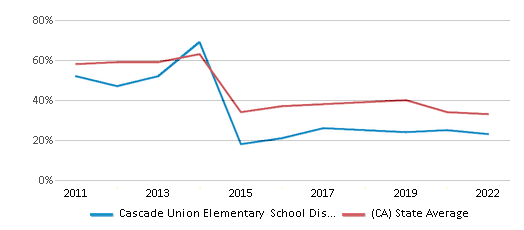
Reading/Language Arts Test Scores (% Proficient)
31%
47%
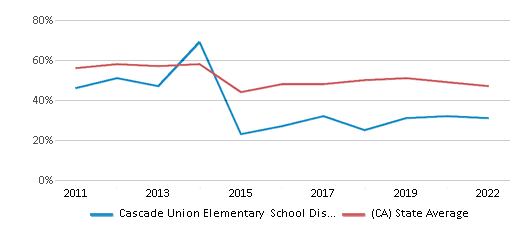
Science Test Scores (% Proficient)
18%
29%
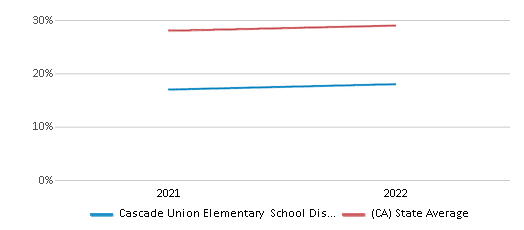
Students by Ethnicity:
Diversity Score
0.64
0.63
# American Indian Students
51 Students
25,796 Students
% American Indian Students
5%
1%
# Asian Students
51 Students
705,807 Students
% Asian Students
5%
12%
# Hispanic Students
239 Students
3,264,561 Students
% Hispanic Students
22%
56%
# Black Students
15 Students
286,112 Students
% Black Students
1%
5%
# White Students
599 Students
1,178,558 Students
% White Students
55%
20%
# Hawaiian Students
11 Students
23,731 Students
% Hawaiian Students
1%
n/a
# Two or more races Students
126 Students
333,755 Students
% of Two or more races Students
11%
6%
Students by Grade:
# Students in PK Grade:
-
83
# Students in K Grade:
165
522,456
# Students in 1st Grade:
118
396,605
# Students in 2nd Grade:
111
414,466
# Students in 3rd Grade:
119
416,628
# Students in 4th Grade:
118
426,361
# Students in 5th Grade:
112
430,587
# Students in 6th Grade:
114
432,997
# Students in 7th Grade:
117
439,621
# Students in 8th Grade:
119
441,777
# Students in 9th Grade:
-
466,534
# Students in 10th Grade:
-
476,585
# Students in 11th Grade:
-
469,511
# Students in 12th Grade:
-
492,627
# Ungraded Students:
-
-
District Revenue and Spending
The revenue/student of $18,846 in this school district is less than the state median of $19,974. The school district revenue/student has stayed relatively flat over four school years.
The school district's spending/student of $17,134 is less than the state median of $18,396. The school district spending/student has stayed relatively flat over four school years.
Total Revenue
$21 MM
$116,387 MM
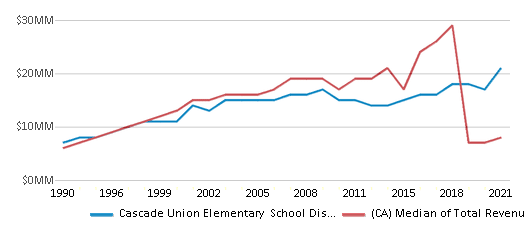
Spending
$19 MM
$107,188 MM
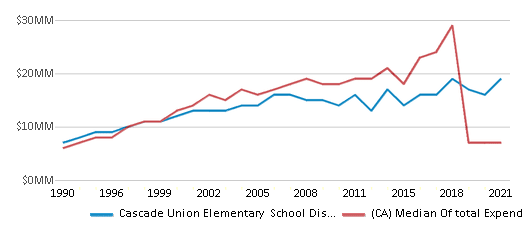
Revenue / Student
$18,846
$19,974
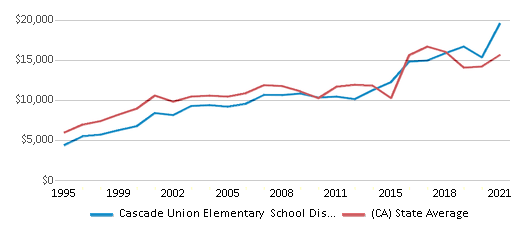
Spending / Student
$17,134
$18,396
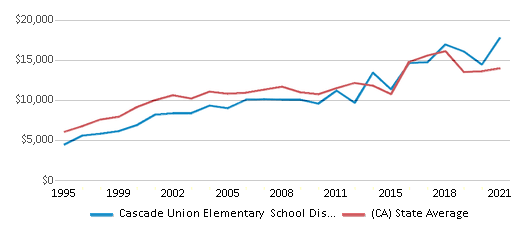
Best Cascade Union Elementary School District Public Schools (2025)
School
(Math and Reading Proficiency)
(Math and Reading Proficiency)
Location
Grades
Students
Rank: #11.
North State Aspire Academy
Alternative School
(Math: <50% | Reading: <50%)
Rank:
Rank:
8/
Top 30%10
1500 Spruce St.
Anderson, CA 96007
(530) 378-7050
Anderson, CA 96007
(530) 378-7050
Grades: K-8
| 9 students
Rank: #22.
Meadow Lane Elementary School
(Math: 30-34% | Reading: 35-39%)
Rank:
Rank:
6/
Top 50%10
2770 Balls Ferry Rd.
Anderson, CA 96007
(530) 378-7030
Anderson, CA 96007
(530) 378-7030
Grades: K-5
| 450 students
Rank: #33.
Anderson Heights Elementary School
(Math: 20-24% | Reading: 25-29%)
Rank:
Rank:
4/
Bottom 50%10
1530 Spruce St.
Anderson, CA 96007
(530) 378-7050
Anderson, CA 96007
(530) 378-7050
Grades: K-5
| 284 students
Rank: #44.
Anderson Middle School
(Math: 19% | Reading: 31%)
Rank:
Rank:
3/
Bottom 50%10
1646 West Ferry St.
Anderson, CA 96007
(530) 378-7060
Anderson, CA 96007
(530) 378-7060
Grades: 6-8
| 350 students
Frequently Asked Questions
How many schools belong to Cascade Union Elementary School District?
Cascade Union Elementary School District manages 4 public schools serving 1,093 students.
What is the rank of Cascade Union Elementary School District?
Cascade Union Elementary School District is ranked #1272 out of 1,925 school districts in California (bottom 50%) based off of combined math and reading proficiency testing data for the 2021-2022 school year.
What is the racial composition of students in Cascade Union Elementary School District?
55% of Cascade Union Elementary School District students are White, 22% of students are Hispanic, 11% of students are Two or more races, 5% of students are American Indian, 5% of students are Asian, 1% of students are Black, and 1% of students are Hawaiian.
What is the student/teacher ratio of Cascade Union Elementary School District?
Cascade Union Elementary School District has a student/teacher ratio of 18:1, which is lower than the California state average of 22:1.
What is Cascade Union Elementary School District's spending/student ratio?
The school district's spending/student of $17,134 is less than the state median of $18,396. The school district spending/student has stayed relatively flat over four school years.
Recent Articles

Year-Round Or Traditional Schedule?
Which is more appropriate for your child? A year-round attendance schedule or traditional schedule? We look at the pros and cons.

Why You Should Encourage Your Child to Join a Sports Team
Participating in team sports has a great many benefits for children, there is no doubt. In this article you will learn what those benefits are.

White Students are Now the Minority in U.S. Public Schools
Increasing birth rates among immigrant families from Asia and Central and South America, combined with lower birth rates among white families, means that for the first time in history, public school students in the United States are majority-minority. This shift in demographics poses difficulties for schools as they work to accommodate children of varying language abilities and socio-economic backgrounds.





